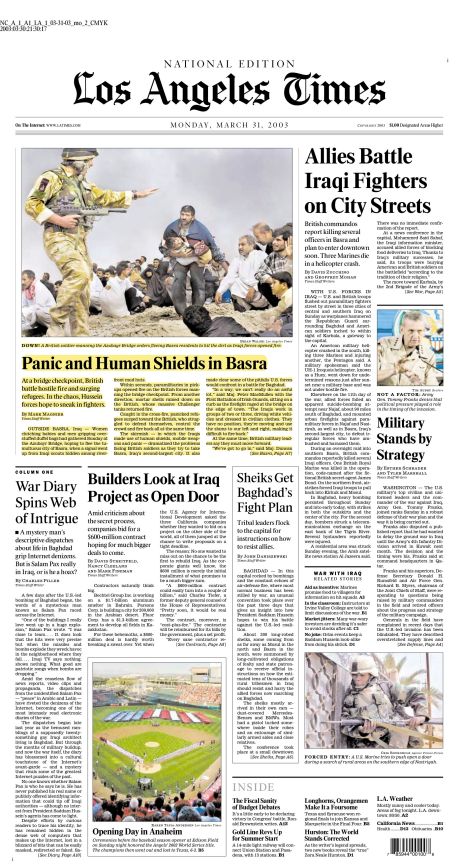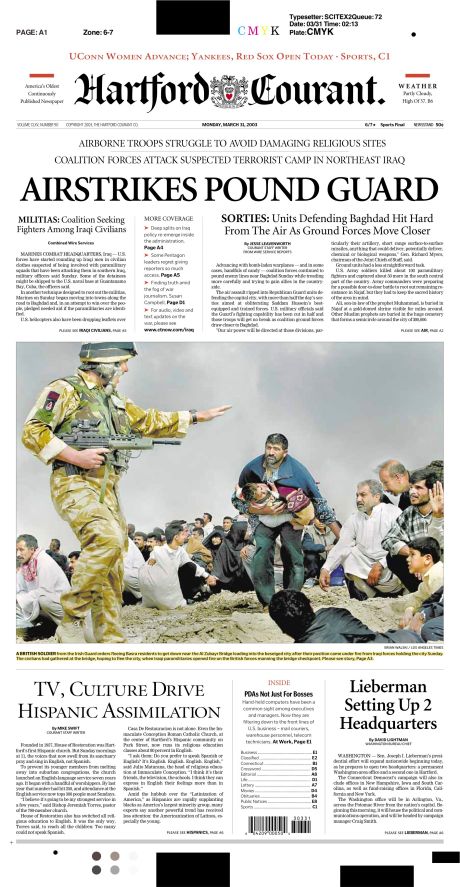The Context of the Scandal
November 2, 2009
‘Saddam Hussein is not disarming. He is a danger to the world. He must disarm. And that’s why I have constantly said and the Prime Minister has constantly said this issue will come to a head in a matter of weeks, not months.’ (Remark made by President George W. Bush on the 31st January 2003, during a press conference with Prime Minister Tony Blair. Office of the Press Secretary, the White House: 2003)
On March 19 at 9:34 p.m. — two days after demanding that Saddam Hussein and his sons Uday and Qusay surrender and leave Iraq within 48 hour — the U.S.-led coalition begins bombing Baghdad. Strikes are first made against “targets of opportunity” on the outskirts of Baghdad. In his address to the nation at 10:16 p.m. e.s.t., President Bush outlines the purpose of invading Iraq: “to disarm Iraq, to free its people, and to defend the world from grave danger.” On March 20th at 7:57 A.M., the first confirmed skirmish between American and Iraqi forces takes place. By 4:00 p.m. that day, there are at least 7 raids on Baghdad. (Singal, Lim and Stephey, 2009)
That is a brief summary on how the Iraq war physically started. Photographer Brian Walski found himself in the outskirt of the southern city of Basra, which was in the process of being taken over by the British forces, at the end of March.
On sunday 30th March, as British troops manned a checkpoint at Azubayr Bridge, a skirmish started when Iraqi paramilitaries opened fire. Civilians had gathered at the checkpoint, hoping to flee the besieged city of Basra, which made the task more difficult for the soldiers of the First Battalion of Irish Guards as they were trying to protect the crowd and defend themselves at the same time.
It is in this tumultuous situation that Walski did his best to capture every moment of the battle. The composite photograph was published on the front pages of the Los Angeles Times and the Hartford Courant (see pdf files below) to illustrate what was happening on the front line at the time. Did the location of the picture in the newspaper aggravate the reaction to the fact that the picture was a fake? For now we can presume that it did, as more people are likely to pay attention to a front page photograph.
What made Brian Walski tweak the reality of the situation? Does the composite in fact alter the message and the viewer’s perception of the situation?
Office of the Press Secretary, The White House (2003) President Bush Meets with Prime Minister Blair, Remarks by the President and British Prime Minister Tony Blair, The White House, The Cross Hall, 31 January 2003. [online] Available from: <http://georgewbush-whitehouse.archives.gov/news/releases/2003/03/20030322.html> [Accessed on 1 November 2009].
Singal, Jesse; Lim, Christine; and Stephey, M.J. (2009). Six Years In Iraq, March 2003, Shock And Awe. [online] Time Inc. Available from: <http://www.time.com/time/2007/iraq/1.html> [Accessed on 26 October 2009].
Hartford Courant [Front Page] (2003). 31st March, p.1. [online] Available from: <http://www.poynter.org/resource/28082/HartfordCourant.pdf> [Accessed on 30 October 2003]
Magnier, Mark (2003). Panic and Human Shields in Basra (front page only). Los Angeles Times, 31st March, p. 1. [online] Available from: <http://www.poynter.org/resource/28082/LATimes.pdf> [Accessed on 30 October 2009].

